Global marketing has become an indispensable strategy for businesses looking to expand their reach and maximize app advertising success.
With millions of apps competing for visibility, crafting a well-structured global marketing strategy is no longer optional; it’s a necessity.
This guide explores the key aspects of strategizing global marketing for app ads, offering actionable tips to enhance your campaigns and achieve measurable results.
- Understanding Cultural Nuances in Global App Marketing
- Leveraging Google Ads for International Reach
- Optimizing App Store Presence for Global Markets
- Measuring and Analyzing Global Campaign Performance
- Embracing Emerging Trends in Global App Advertising
- Bringing It All Together: Mastering Global Marketing for App Ads
- Frequently Asked Questions on Global Marketing Strategies for App Ads
Understanding Cultural Nuances in Global App Marketing
One of the most critical aspects of global marketing is understanding and respecting cultural differences.
Your app ads need to resonate with audiences across different regions, and a one-size-fits-all approach rarely works.
When you tailor your marketing strategies to align with cultural preferences, you build trust and improve engagement.
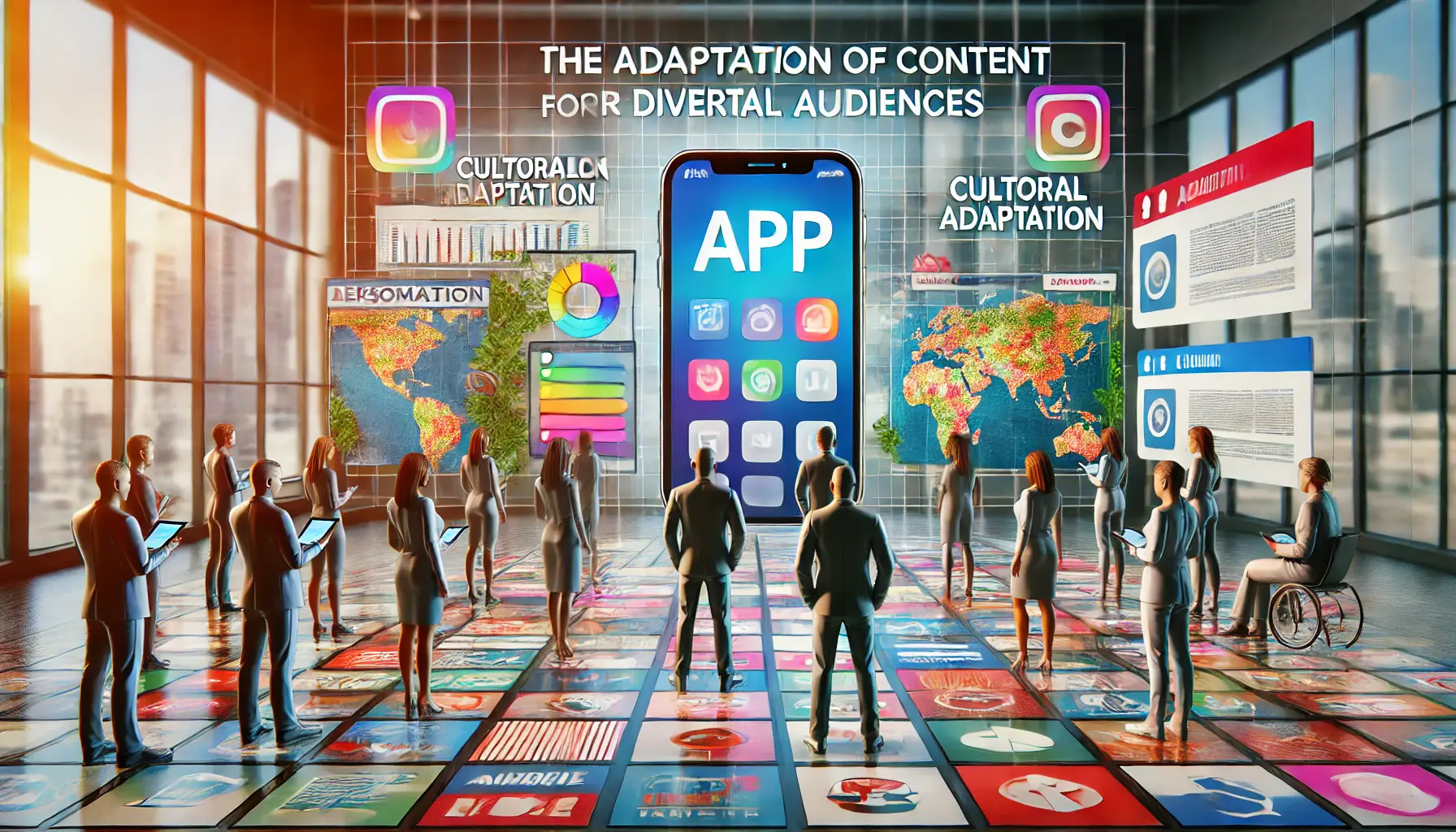
Illustration of content adaptation for diverse audiences, with human figures from various cultures engaging with localized app interfaces.
Adapting Content for Diverse Audiences
Every culture interprets visuals, words, and symbols differently.
The success of an ad campaign, which works in one region, may completely fail in another due to cultural misunderstandings.
Start by researching the preferences, values, and sensitivities of your target audience.
Then use language, imagery, and tones that fit their expectations.
Endeavor to use localized languages and colloquial phrases appropriately.
- Avoid using imagery or symbols that might be misinterpreted or offensive.
- Test your campaigns with focus groups from each region to ensure cultural relevance.

Illustration of how localization enhances user engagement through tailored app interfaces with diverse currencies and measurement units.
The Role of Localization in User Engagement
Localization goes beyond translation; it’s all about crafting your ad for your app to feel native to the user.
For instance, the currency, date format, and measurement units should be aligned with local standards.
This ensures that users feel catered to and understood.
- Integrate localized keywords to increase visibility in search ads.
- Ensure your visual content reflects the target demographic.
- Emphasize region-specific features or benefits of your app in the ad.
By taking cultural nuances seriously, you can create ads that not only attract attention but also drive meaningful engagement.
This is the starting point toward a successful global app marketing strategy.
Cultural differences are crucial in app marketing. Adapting content, language, and visuals to resonate with regional audiences builds trust and boosts engagement.
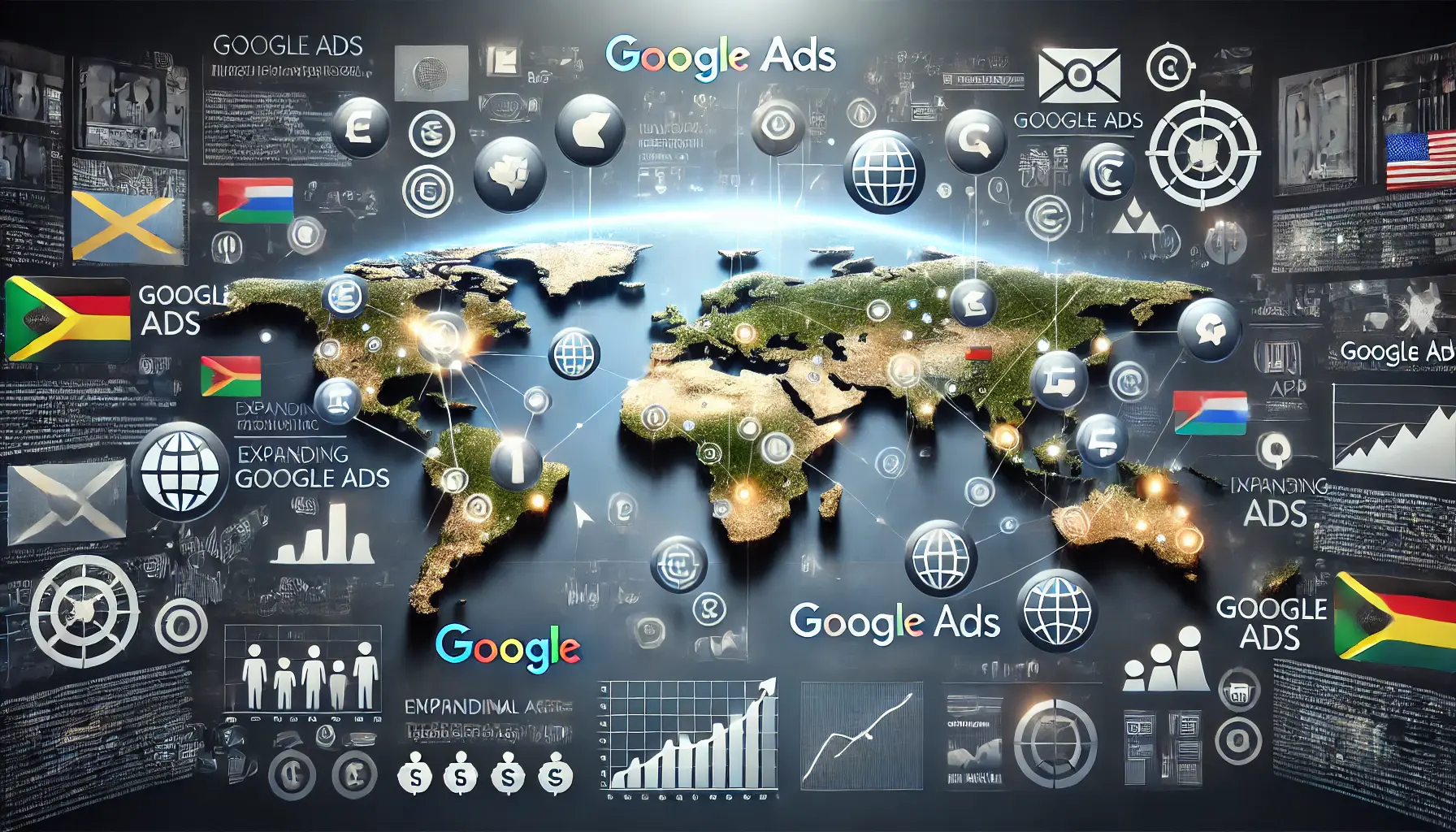
Illustration of leveraging Google Ads for international reach, with a world map and digital marketing elements like currencies and app icons.
Leveraging Google Ads for International Reach
Expanding your app’s presence globally requires a strategic approach, and Google Ads offers robust tools to facilitate this expansion.
By effectively utilizing its features, you can connect with diverse audiences and drive app engagement across multiple regions.
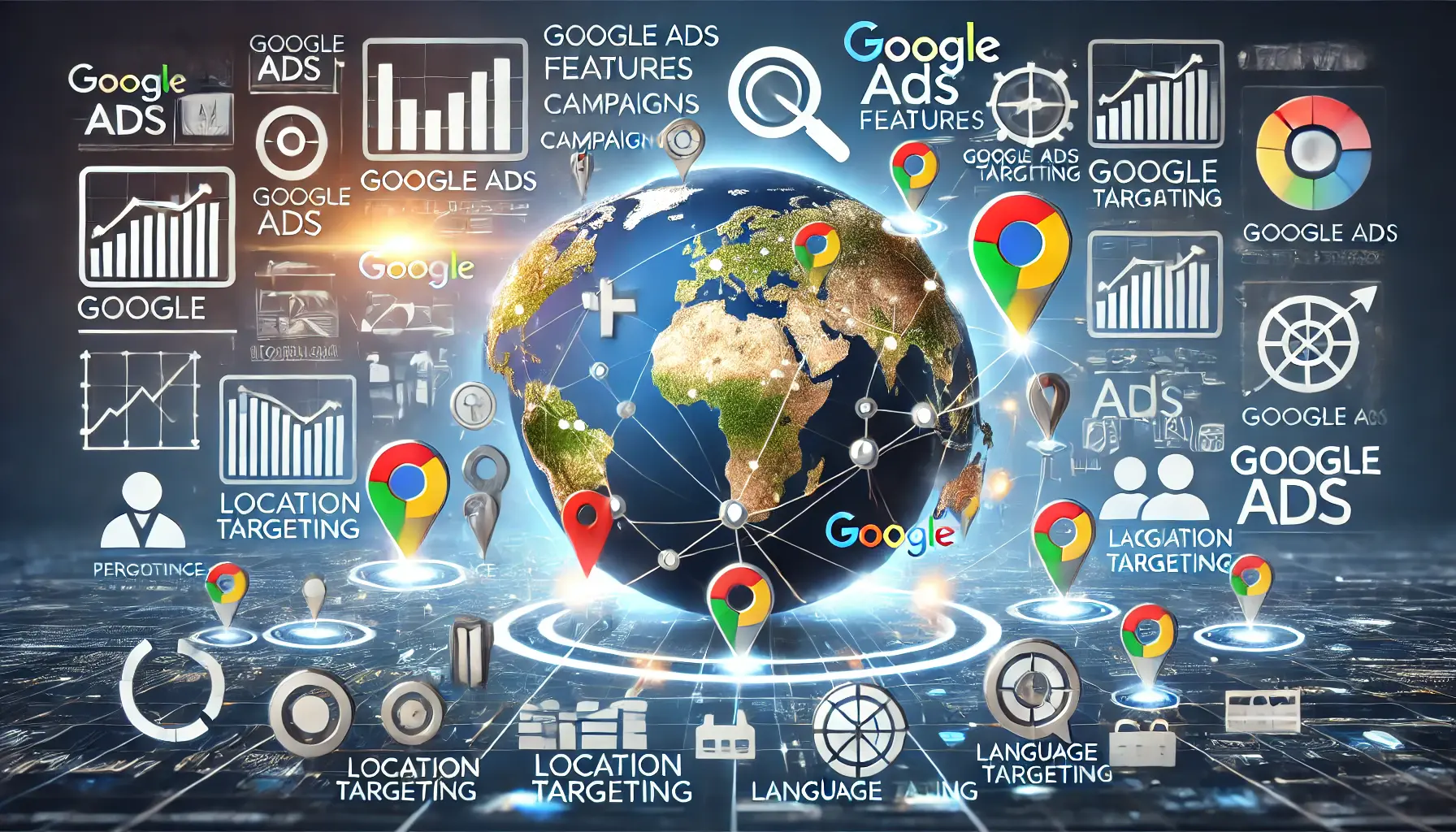
Illustration of using Google Ads features for global campaigns, with a world map, performance graphs, and location and language targeting elements.
Utilizing Google Ads Features for Global Campaigns
Google Ads provides several features tailored for international marketing:
- Performance Max Campaigns: AI-powered campaigns that enable you to reach users throughout Google channels such as Search, Display, YouTube, and more, while optimizing performance for your specific goals.
- Location Targeting: Target with high precision any country, region, or city so that your ads match the exact audience of your app.
- Language Targeting: Deliver ads in the native language of your target audience to enhance relevance and engagement.
Integrating these features into your global marketing strategy can significantly enhance your app’s visibility and user acquisition in diverse markets.

Illustration of setting up targeted campaigns across multiple regions, with a global map and elements representing customization for different markets.
Setting Up Targeted Campaigns Across Multiple Regions
To effectively manage campaigns across various regions, consider the following steps:
- Campaign Segmentation: Create separate campaigns for each target region to tailor ad content and bidding strategies to local tastes, preferences, and competition levels.
- Ad Scheduling: Time your ad deliveries to coincide with the most active hours of each region for maximum interaction.
- Budget Allocation: Allocate your budget based on the potential and performance of each market, allowing flexibility and optimization.
Applying these practices will help you effectively leverage Google Ads to boost the visibility and engagement of your app on a global scale.
Google Ads provides powerful tools like Performance Max, location targeting, and language targeting to expand app reach across diverse markets effectively.
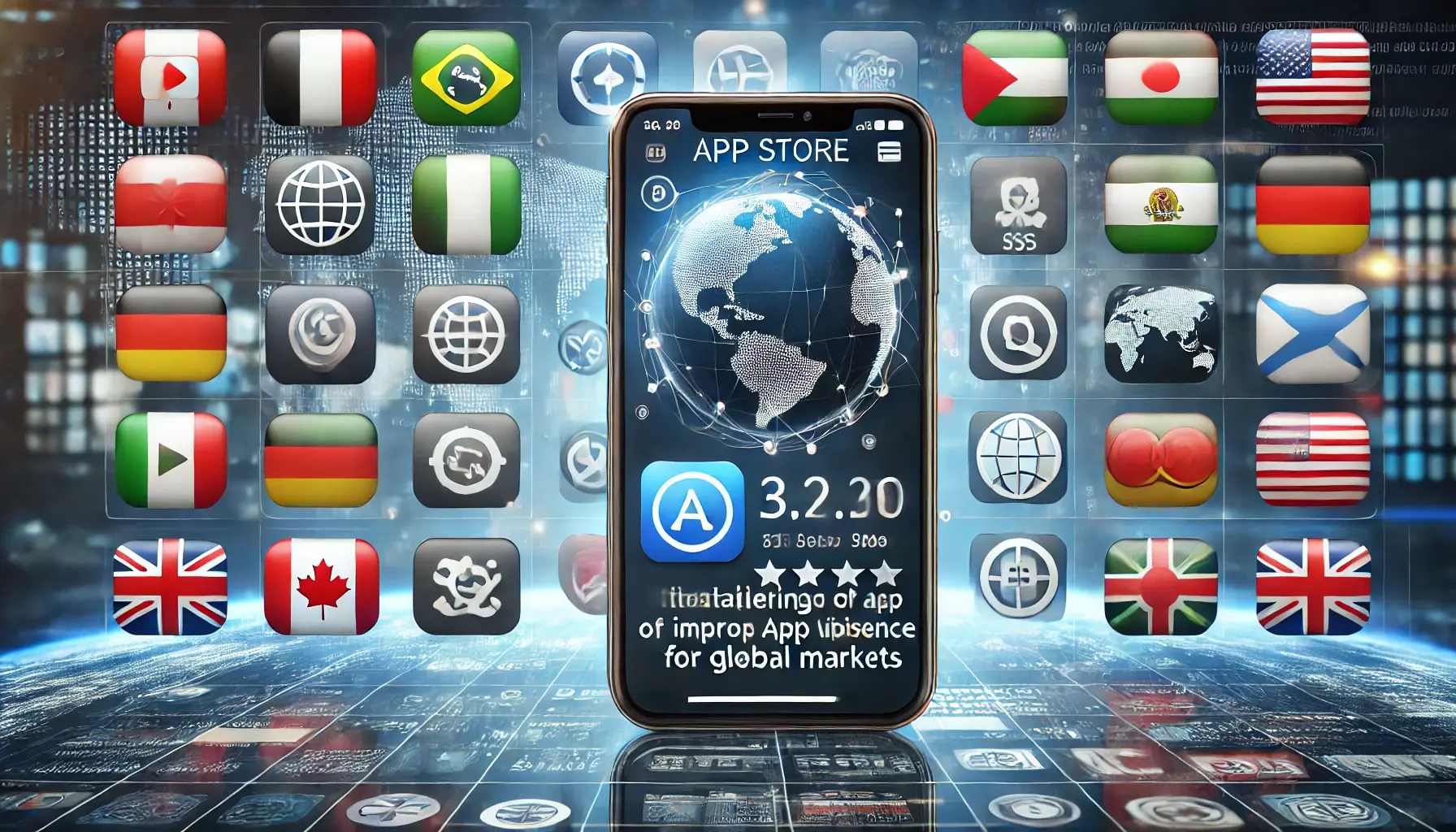
Illustration of optimizing app store presence for global markets, featuring a smartphone with localized visuals and app store elements.
Optimizing App Store Presence for Global Markets
Expanding your app’s reach into global markets requires a strategic approach to App Store Optimization (ASO).
By tailoring your app’s store presence to resonate with diverse audiences, you can enhance visibility and drive downloads worldwide.
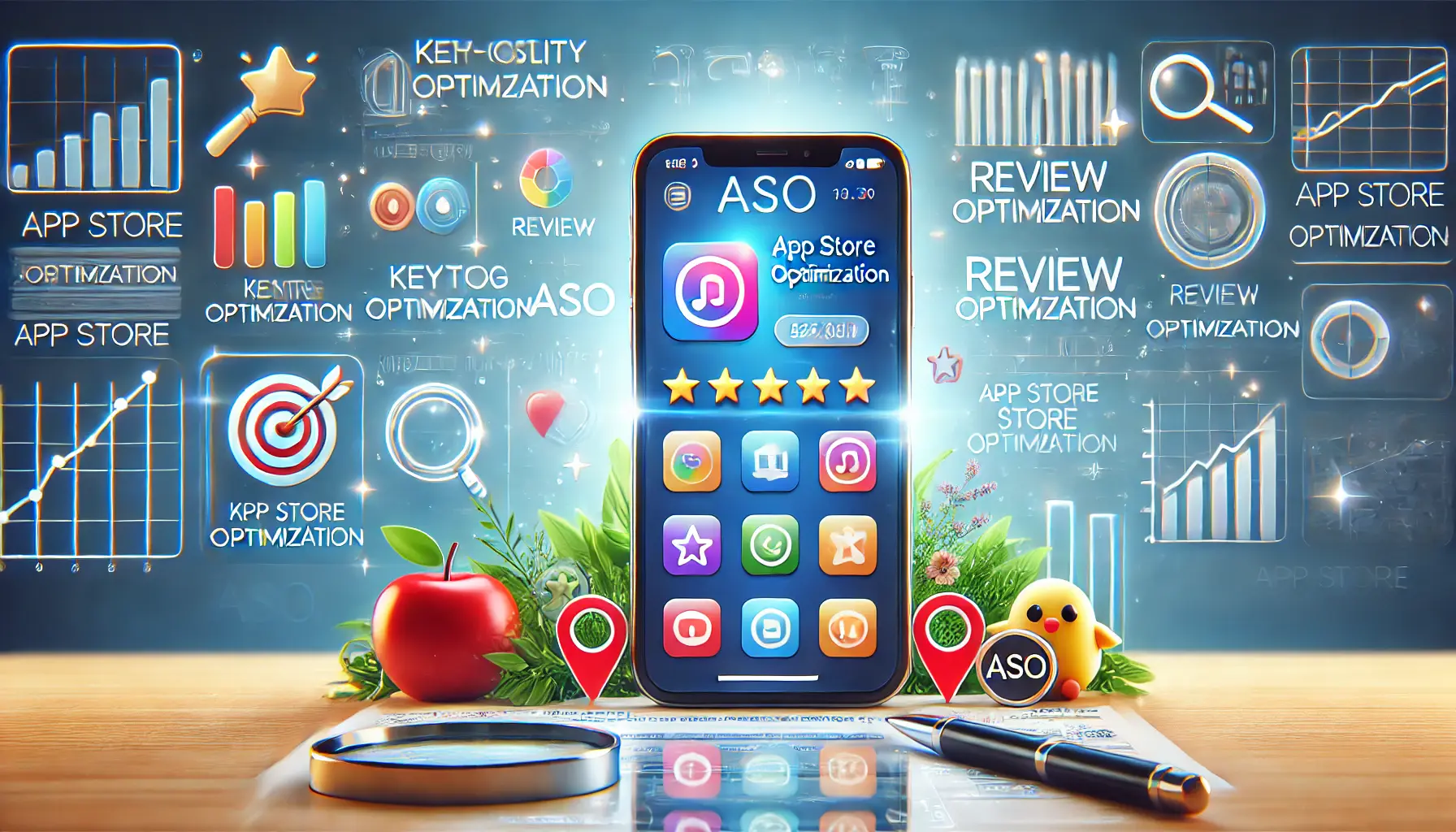
Illustration of App Store Optimization (ASO) strategies, featuring a smartphone with app icons, reviews, and elements symbolizing ASO processes like keyword research and visual optimization.
App Store Optimization (ASO) Strategies
Effective ASO is crucial for standing out in crowded app marketplaces.
Consider the following strategies:
- Keyword Research: Incorporate keywords that probable users are likely to use. This improves the visibility of your application in search results.
- Compelling Visuals: Use quality icons, screenshots, and videos that clearly convey your app’s value and appeal to your targeted audience.
- Positive Reviews and Ratings: Encourage satisfied users to leave feedback. High ratings contribute to increased credibility and visibility.
Implementing these ASO strategies can significantly enhance your app’s discoverability and attractiveness to users across various markets.

Illustration of the importance of localized app descriptions and keywords, featuring a smartphone with localized visuals and digital elements representing different cultures and languages.
Importance of Localized App Descriptions and Keywords
Localization involves more than just translating text; it’s about adapting your app to meet the cultural and linguistic preferences of each target market.
Key considerations include:
- Localized Keywords: Research and integrate keywords that are popular and relevant in each specific region to improve search visibility.
- Translated Descriptions: Provide app descriptions in the native language of each market, ensuring they are culturally appropriate and engaging.
- Localized Visuals: Modify images and videos to reflect local customs and preferences, making your app more relatable to users.
By localizing your app’s store presence, you demonstrate a commitment to serving diverse audiences, which can lead to increased trust and higher download rates.
App Store Optimization (ASO) tailored for global audiences significantly enhances discoverability. Localized visuals and descriptions make your app more appealing and relatable.

Illustration of measuring and analyzing global campaign performance, with a digital screen displaying various data points, charts, and visual analytics.
Measuring and Analyzing Global Campaign Performance
Effectively measuring and analyzing your global marketing campaigns is crucial for understanding their impact and optimizing future strategies.
By focusing on key performance indicators (KPIs) and employing data-driven decision-making, you can enhance your app’s success across diverse markets.

Illustration of key metrics for evaluating success, with a digital dashboard showing performance graphs and KPIs like user acquisition cost and conversion rates.
Key Metrics for Evaluating Success
Monitoring the right metrics provides insights into your campaign’s effectiveness.
Consider the following KPIs:
- User Acquisition Cost (UAC): Calculates the average expense incurred to acquire a new user, helping assess the efficiency of your marketing spend.
- Engagement Rates: Measures user interactions, such as session duration and frequency, indicating the app’s ability to retain users.
- Conversion Rates: Tracks the percentage of users who complete desired actions, like in-app purchases, reflecting the campaign’s success in driving valuable user behavior.
Regularly analyzing these metrics enables you to identify strengths and areas for improvement in your global marketing efforts.

Illustration of tools and techniques for data-driven decisions, featuring a modern analytics dashboard with graphs and performance tracking elements.
Tools and Techniques for Data-Driven Decisions
Leveraging appropriate tools and methodologies is essential for informed decision-making.
Consider the following approaches:
- Analytics Platforms: Utilize tools like Google Analytics and AppsFlyer to gather comprehensive data on user behavior and campaign performance.
- A/B Testing: Run controlled experiments to test different campaign elements and optimize based on user preferences.
- Dashboard Reporting: Create KPI dashboards that consolidate and visualize data in one place, making it easy to monitor and analyze campaign metrics effectively.
By integrating these tools and techniques, you can make informed, data-driven decisions to enhance your global marketing campaigns.
Key metrics like user acquisition cost, engagement rates, and conversion rates offer actionable insights into campaign performance and improvement areas.

Illustration of emerging trends in global app advertising, featuring a smartphone with AR elements and digital symbols for AI and machine learning.
Embracing Emerging Trends in Global App Advertising
Staying abreast of emerging trends in global app advertising is essential for maintaining a competitive edge.
By integrating innovative technologies and strategies, you can enhance user engagement and expand your app’s reach across diverse markets.

Illustration of AI and machine learning in advertising, showcasing personalized ad content and digital symbols representing data analytics and predictive algorithms.
Artificial Intelligence and Machine Learning in Advertising
AI and ML are rapidly changing digital advertising by allowing more personal and effective advertising campaigns.
These technologies analyze vast amounts of data to predict user behavior and make targeted ad placements that resonate with specific audiences.
The implementation of AI and ML can drive higher conversion rates and increased ROI.
- Predictive Analytics: Utilize AI to forecast user trends and tailor your marketing strategies accordingly.
- Automated Ad Placement: Leverage ML algorithms to optimize ad placements in real-time, ensuring maximum visibility and engagement.
- Personalized Content: Create dynamic ad content that adapts to individual user preferences, enhancing relevance and effectiveness.

Illustration of augmented reality and interactive ad experiences, with a smartphone showing virtual elements and interactive product features.
Augmented Reality and Interactive Ad Experiences
AR is transforming the advertising landscape by offering immersive and interactive experiences.
AR ads engage users in new ways, helping to build deeper connections with your app and brand.
Integrating AR into your advertising can help your app stand out in a crowded marketplace.
- Virtual Try-Ons: Allow users to see how products would look in your app, making the shopping experience easier and reducing hesitation.
- Interactive Storytelling: Develop AR narratives that captivate users, increasing time spent within the app and boosting engagement metrics.
- Location-Based Experiences: Implement AR features that provide contextual content based on the user’s location, adding value and relevance.
By embracing these emerging trends, you can elevate your global app advertising efforts, ensuring they are innovative, engaging, and effective in reaching and resonating with your target audiences.
Incorporating AI, machine learning, and augmented realityA technology that overlays digital elements onto the real world, often used for interactive and immersive experiences. transforms app advertising, offering personalized and engaging user experiences that stand out in competitive markets.

Illustration of mastering global marketing for app ads, with a globe and interconnected digital elements representing various regions and marketing strategies.
Bringing It All Together: Mastering Global Marketing for App Ads
In today’s competitive app marketplace, effective global marketing strategies are essential for success.
By leveraging the insights and techniques discussed in this guide, you can optimize your app advertising campaigns to achieve meaningful results across diverse markets.
Here’s a summary of the key points to remember as you implement your global marketing plan.

Illustration of understanding cultural nuances in marketing, with diverse people engaging with culturally tailored app interfaces and symbols representing various cultures.
Understanding the Importance of Cultural Nuances
Adapting your campaigns to reflect cultural differences is crucial for building trust and relevance with your target audiences.
Tailor your content, visuals, and tone to resonate with regional preferences and avoid potential misinterpretations.

Illustration of maximizing reach with Google Ads, featuring a globe with targeting lines and digital ad icons representing global campaign optimization.
Maximizing Reach with Google Ads
Google Ads offers powerful tools to connect with global audiences.
Use features like Performance Max CampaignsAI-powered ad campaigns by Google that optimize performance across multiple channels like Search, Display, and YouTube., location targeting, and language targeting to enhance the reach and engagement of your campaigns.
Ensure that your strategy includes segmentation and localized approaches for greater impact.
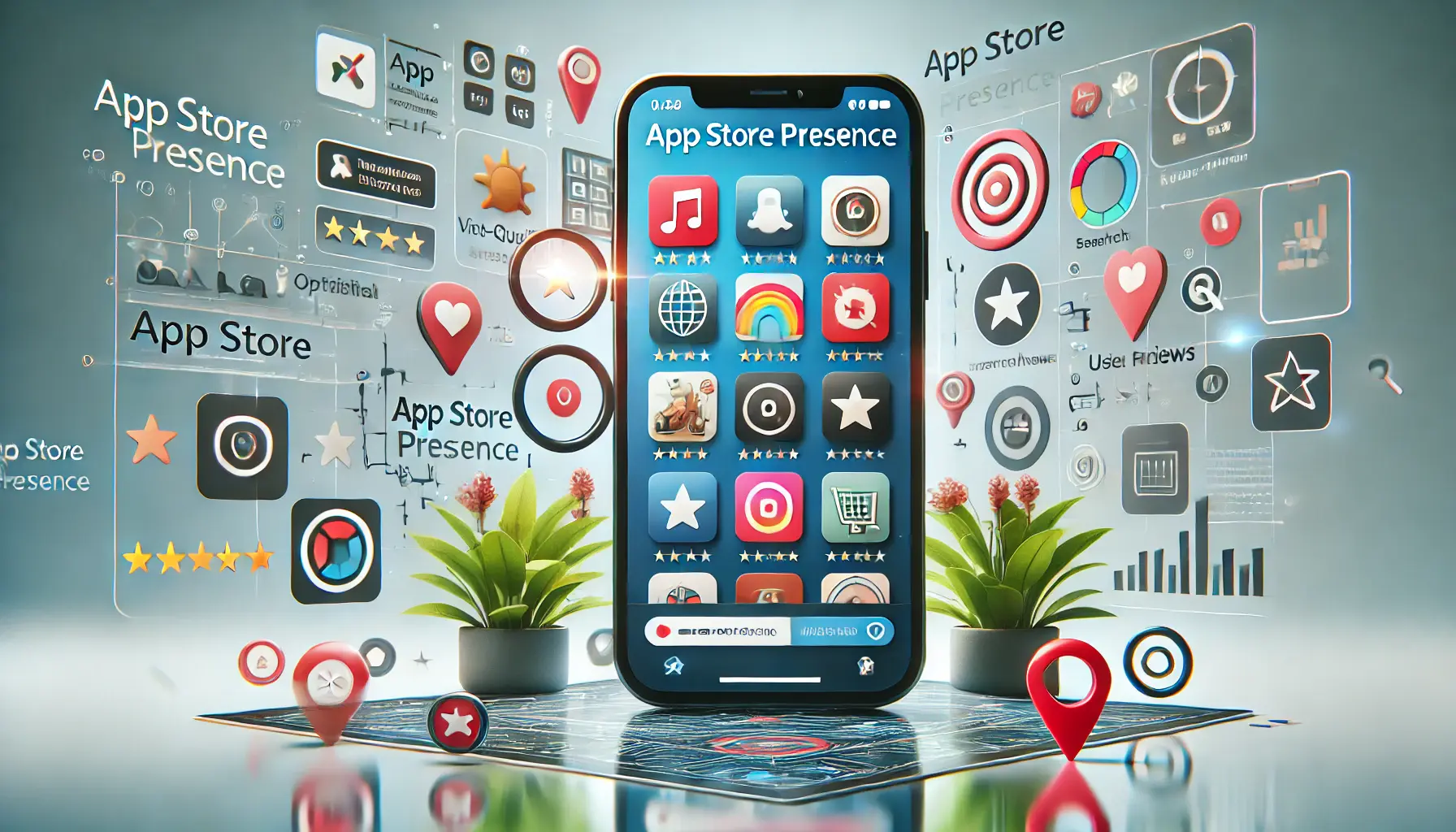
Illustration of optimizing your app store presence, featuring a smartphone with engaging app visuals, reviews, and ratings.
Optimizing Your App Store Presence
App Store Optimization (ASO) is a vital component of global marketing.
By conducting keyword research, utilizing compelling visuals, and localizing app descriptions and keywords, you can significantly improve your app’s discoverability and appeal to users worldwide.

Illustration of measuring success and making data-driven decisions, featuring a digital dashboard with key performance indicators and data analysis tools.
Measuring Success and Making Data-Driven Decisions
Tracking key metrics such as user acquisition cost, engagement rates, and conversion rates provides valuable insights into the effectiveness of your campaigns.
Leverage tools like Google Analytics and A/B testingA method of comparing two versions of a campaign element to determine which performs better. to refine your strategies and achieve better outcomes.

Illustration of embracing emerging trends, featuring smart devices, holographic interfaces, and data-driven analytics in a futuristic setting.
Embracing Emerging Trends
Keep pace with innovations in the market, such as artificial intelligence, machine learning, and augmented reality, which help make your campaigns more personalized, engaging, and interactive.
These advancements give your app a distinct position in the competitive marketplace.
By integrating these strategies and staying informed about the latest trends, you will be able to effectively strategize your international marketing to drive success in running app ads.
With a focus on adaptability, innovation, and data-driven decisions, your app has the potential for long-term growth and acknowledgment in the international arena.
Success in global app marketing requires understanding cultural nuances, leveraging Google Ads, optimizing ASO, analyzing performance, and staying ahead with emerging trends.

Illustration of frequently asked questions on global marketing strategies for app ads, featuring digital devices and interactive symbols representing inquiry and exploration.
Your campaigns can be managed by an agency specialized in Google Ads, check out our service page.
Frequently Asked Questions on Global Marketing Strategies for App Ads
Understanding cultural nuances ensures your app ads resonate with diverse audiences, building trust and enhancing engagement across different regions.
Google Ads offers tools like location and language targeting, enabling precise audience engagement and improved app visibility in global markets.
ASO improves app discoverability by optimizing keywords, visuals, and descriptions, attracting users worldwide and increasing download rates.
Key metrics include user acquisition cost, engagement rates, and conversion rates, providing insights into campaign effectiveness and areas for improvement.











